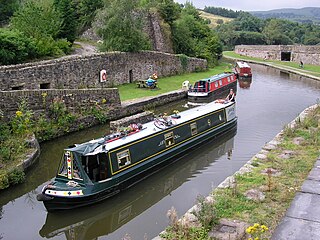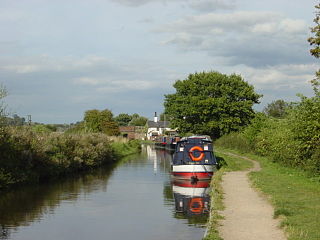
A barge a typically flat-bottomed vessel which does not have its own means of mechanical propulsion. Original use was on inland waterways, while modern use is on both inland and marine water environments. The first modern barges were pulled by tugs, but on inland waterways, most are pushed by pusher boats, or other vessels. The term barge has a rich history, and therefore there are many types of barges.

A narrowboat is a particular type of canal boat, built to fit the narrow locks of the United Kingdom. The UK's canal system provided a nationwide transport network during the Industrial Revolution, but with the advent of the railways, commercial canal traffic gradually diminished and the last regular long-distance transportation of goods by canal had virtually disappeared by 1970. However, some commercial traffic continued. From the 1970s onward narrowboats were gradually being converted into permanent residences or as holiday lettings. Currently, about 8,580 narrowboats are registered as 'permanent homes' on Britain's waterway system and represent a growing alternative community living on semi-permanent moorings or continuously cruising.

The Trent and Mersey Canal is a 93+1⁄2-mile (150 km) canal in Derbyshire, Staffordshire and Cheshire in north-central England. It is a "narrow canal" for the vast majority of its length, but at the extremities to the east of Burton upon Trent and north of Middlewich, it is a wide canal.

James Brindley was an English engineer. He was born in Tunstead, Derbyshire, and lived much of his life in Leek, Staffordshire, becoming one of the most notable engineers of the 18th Century.

A steamboat is a boat that is propelled primarily by steam power, typically driving propellers or paddlewheels. The term steamboat is used to refer to small steam-powered vessels working on lakes, rivers, and in short-sea shipping. The development of the steamboat led to the larger steamship, which is a seaworthy and often ocean-going ship.

The canal network of the United Kingdom played a vital role in the Industrial Revolution. The UK was the first country to develop a nationwide canal network which, at its peak, expanded to nearly 4,000 miles in length. The canals allowed raw materials to be transported to a place of manufacture, and finished goods to be transported to consumers, more quickly and cheaply than by a land based route. The canal network was extensive and included feats of civil engineering such as the Anderton Boat Lift, the Manchester Ship Canal, the Worsley Navigable Levels and the Pontcysyllte Aqueduct.

The Black Country Living Museum is an open-air museum of rebuilt historic buildings in Dudley, West Midlands, England. It is located in the centre of the Black Country, 10 miles west of Birmingham. The museum occupies 10.5 hectares of former industrial land partly reclaimed from a former railway goods yard, disused lime kilns, canal arm and former coal pits.

The canals of the United Kingdom are a major part of the network of inland waterways in the United Kingdom. They have a varied history, from use for irrigation and transport, through becoming the focus of the Industrial Revolution, to today's role of recreational boating. Despite a period of abandonment, today the canal system in the United Kingdom is again increasing in use, with abandoned and derelict canals being reopened, and the construction of some new routes. Canals in England and Wales are maintained by navigation authorities. The biggest navigation authorities are the Canal & River Trust and the Environment Agency, but other canals are managed by companies, local authorities or charitable trusts.

St Pancras Cruising Club is a members’ club based in London Borough of Camden that exists to promote pleasure cruising on UK inland waterways and to provide facilities for its members and others. Most Club members own boats but the Club also welcomes anyone who is interested in boating and inland waterways.

A Dutch barge is a traditional flat-bottomed shoal-draught barge, originally used to carry cargo in the shallow Zuiderzee and the waterways of Netherlands. There are many types of Dutch barge, with characteristics determined by regional conditions and traditions.

The National Community Boats Association (NCBA) is a waterway society, registered charity No. 1108993 and limited company No. 5331820, in the United Kingdom.

Sundowner is a motor yacht formerly owned by Charles Lightoller, former second officer of the RMS Titanic.

Fellows Morton & Clayton Ltd was, for much of the early 20th century, the largest and best-known canal transportation company in England. The company was in existence from 1889 to 1947.

Amazon is a 102-foot (31 m) long screw schooner and former steam yacht built in 1885 at the private Arrow Yard of Tankerville Chamberlayne in Southampton.

The Thames Diamond Jubilee Pageant was a parade on 3 June 2012 of 670 boats on the Tideway of the River Thames in London as part of the celebrations of the Diamond Jubilee of Elizabeth II. The Queen, Prince Philip and other members of the Royal Family were aboard vessels that took part in the parade. The parade was organised by the Thames Diamond Jubilee Foundation, and funded by private donations and sponsorship. The pageant master was Adrian Evans.

Kildare is an un-powered butty boat constructed with wrought iron sides and an elm bottom. She was built for Fellows Morton & Clayton around 1913 by Braithwaite & Kirk of West Bromwich to be towed behind a powered craft like President. She is complete with a fully fitted boatman's living cabin and traditional covering cloths over the main hold area.

Peacock is a British narrowboat. She was built as a flyboat for Fellows Morton & Clayton (FMC) at Saltley, Birmingham in 1915, as fleet number 102. FMC had been using a fleet of steam fly boats since 1889, but in 1912 introduced motor boats such as Peacock into their fleet. 'Fly' boats work day and night non-stop, and with an all-male crew the cabins were more spartan than those of long distance family crewed boats.

The Stour is an all-wooden motor narrow boat powered by a Bolinder 11 kW diesel engine. It was built as a tar tanker in 1937 by Fellows Morton & Clayton at their Uxbridge dockyard for fuel oil carriers Thomas Clayton Ltd of Oldbury.

A widebeam is a canal boat built in the style of a British narrowboat but with a beam of 2.16 metres or greater.

Steam Pinnace 199 is a steam pinnace of the Royal Navy, built in 1909 by J. Reid of Portsmouth. She is now owned by the National Museum of the Royal Navy, and is based at Portsmouth Historic Dockyard.























